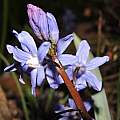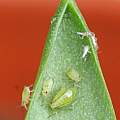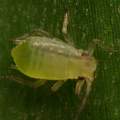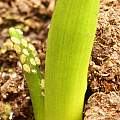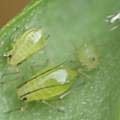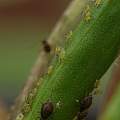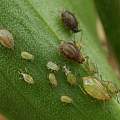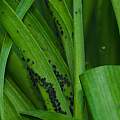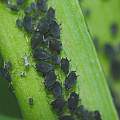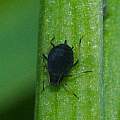Aphids are sap sucking insects. They cause distorted growth and in the long term spread disease from plant to plant. They are 'farmed' by ants for the sweet 'honeydew' they produce and this sugary sticky residue on plants is one sign of their presence. Another signal is the white skin they shed.
Aphids are often blamed for spreading viruses between bulbs. The honeydew can be the site of fungal growth. For bulbs a favourite target are new shoots in Spring.
Since they are a common pest affecting many plants there are lots of treatments, ranging from soapy water sprays to systemic insecticides like imidacloprid (sold as Provado). For small scale outbreaks digital squishing is effective. In some situations they produce offspring with wings, otherwise they're fairly immobile making shaking them off plants or washing them off, a fair strategy. Growth in numbers is exponential so it is important to stop them as soon as possible.
Natural predators of aphids include ladybugs and hoverflies. A healthy predatory population can be sustained with help from the gardener. Adult ladybugs will predate on aphids, but it is the larvae of syrphid flies (hoverflies) which predate on the aphids. The adult syrphid flies feed on nectar and pollen, so supplying them with flowering plants the year round (except winter) will help. They prefer "shallow flowers" like those of many herbs like those in the mint family, but especially herbs in the Apiaceae, such as dill (Anethum graveolens), parsley (Petroselinum crispum), Angelica sp., chervil (Anthriscus cerefolium), anise (Pimpinella anisum), Coriander/cilantro (Coriandrum sativum), Lomatium sp., and many others. Such culinary and medicinal herbs can be started easily from seed by direct seeding in the Autumn or early Spring. Remember, pesticide does equal damage to both the "good" bugs (including bees, spiders, and butterflies) as it does to the "bad" bugs.
Travis Owen observed these aphids on his Chionodoxa sardensis, only to find they had all but disappeared in a few days time. Whether this was due to natural predators or the weather is unclear, but they had inflicted little damage despite their fairly large numbers.
There are several genera of green fly, including Aphis, Macrosiphum and Myzus
Photographs by David Pilling. Bits of the typical shed white skin can be seen in the first and fourth. Dark colored bugs as shown in the last two photographs may not be another species of aphid, but dead or dying ones, perhaps the result of insecticide taking effect or the attentions of parasites. However there are aphids of different colors.
Aphis fabae is commonly known as black bean aphid, or black fly. It is often a scourge of Dahlia, but in the photos below is living on Polianthes tuberosa.
Click here to see PBS list postings about aphids.
